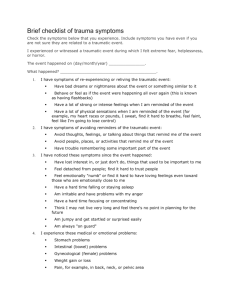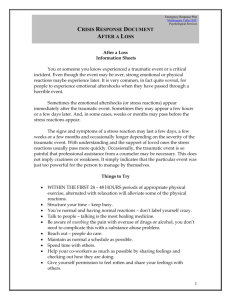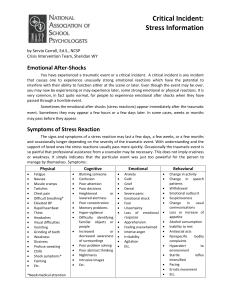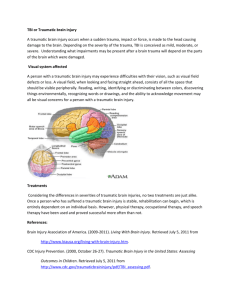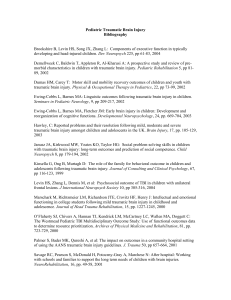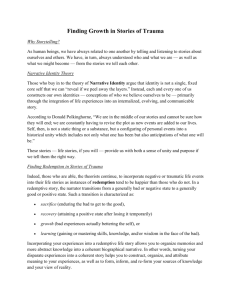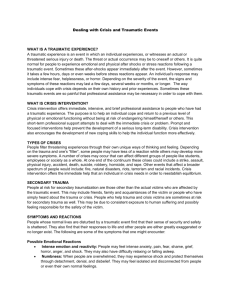Additional References
advertisement
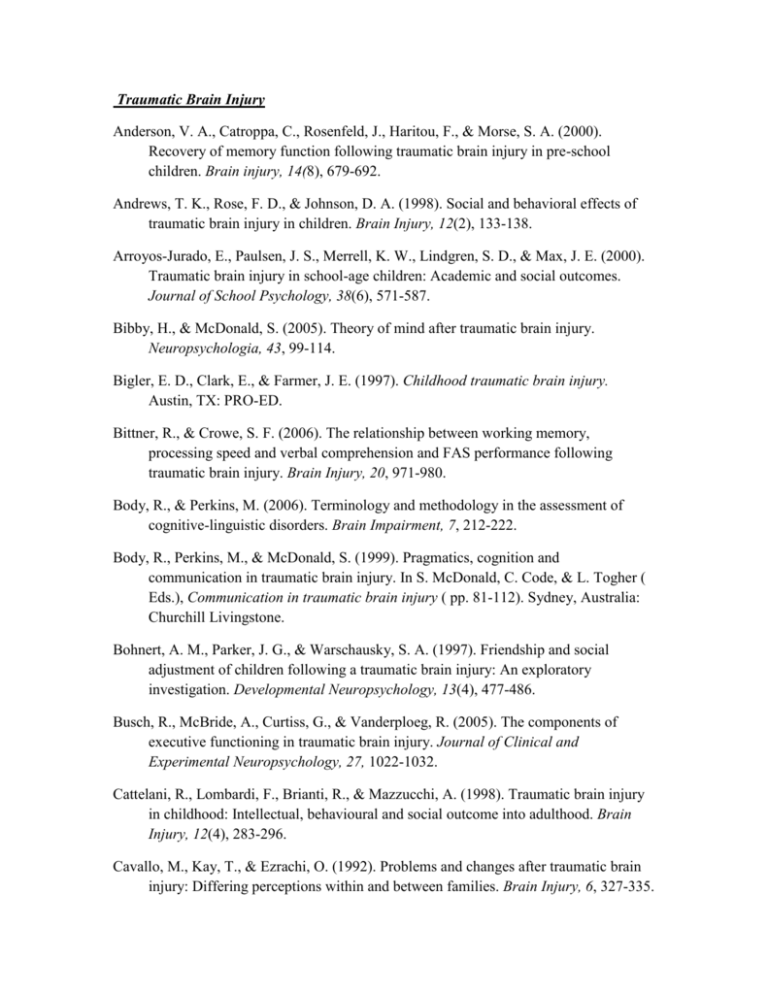
Traumatic Brain Injury Anderson, V. A., Catroppa, C., Rosenfeld, J., Haritou, F., & Morse, S. A. (2000). Recovery of memory function following traumatic brain injury in pre-school children. Brain injury, 14(8), 679-692. Andrews, T. K., Rose, F. D., & Johnson, D. A. (1998). Social and behavioral effects of traumatic brain injury in children. Brain Injury, 12(2), 133-138. Arroyos-Jurado, E., Paulsen, J. S., Merrell, K. W., Lindgren, S. D., & Max, J. E. (2000). Traumatic brain injury in school-age children: Academic and social outcomes. Journal of School Psychology, 38(6), 571-587. Bibby, H., & McDonald, S. (2005). Theory of mind after traumatic brain injury. Neuropsychologia, 43, 99-114. Bigler, E. D., Clark, E., & Farmer, J. E. (1997). Childhood traumatic brain injury. Austin, TX: PRO-ED. Bittner, R., & Crowe, S. F. (2006). The relationship between working memory, processing speed and verbal comprehension and FAS performance following traumatic brain injury. Brain Injury, 20, 971-980. Body, R., & Perkins, M. (2006). Terminology and methodology in the assessment of cognitive-linguistic disorders. Brain Impairment, 7, 212-222. Body, R., Perkins, M., & McDonald, S. (1999). Pragmatics, cognition and communication in traumatic brain injury. In S. McDonald, C. Code, & L. Togher ( Eds.), Communication in traumatic brain injury ( pp. 81-112). Sydney, Australia: Churchill Livingstone. Bohnert, A. M., Parker, J. G., & Warschausky, S. A. (1997). Friendship and social adjustment of children following a traumatic brain injury: An exploratory investigation. Developmental Neuropsychology, 13(4), 477-486. Busch, R., McBride, A., Curtiss, G., & Vanderploeg, R. (2005). The components of executive functioning in traumatic brain injury. Journal of Clinical and Experimental Neuropsychology, 27, 1022-1032. Cattelani, R., Lombardi, F., Brianti, R., & Mazzucchi, A. (1998). Traumatic brain injury in childhood: Intellectual, behavioural and social outcome into adulthood. Brain Injury, 12(4), 283-296. Cavallo, M., Kay, T., & Ezrachi, O. (1992). Problems and changes after traumatic brain injury: Differing perceptions within and between families. Brain Injury, 6, 327-335. Centers for Disease Control and Prevention (CDC). (1999). Facts about concussion and brain injury. Atlanta: Author. Clark, E. (1997). Children and adolescents with traumatic brain injury: Reintegration challenges in educational settings. In E. D. Bigler, E. Clark, & J. E. Farmer (Eds.), Childhood traumatic brain injury: Diagnosis. assessment, and intervention (pp. 191-211 ). Austin, TX: PRO-ED. Clark, E., Russman, S., & Orme, S. F. (1999). Traumatic brain injury: Effects on school functioning and intervention strategies. School Psychology Review, 28(2), 242-250. Cockrell, J. L., & Nickel, R. E. (2000). Traumatic brain injury. In R. E. Nickel & L. W. Desch (Eds.), The physician's guide to caring for children with disabilities and chronic conditions (pp. 513-527). Baltimore: Brookes. D'Amato, R. C., & Rothlisberg, B. A. (1997). How education should respond to students with traumatic brain injury. In E. D. Bigler, E. Clark, & J. E. Farmer (Eds.), Childhood traumatic brain injury (pp. 213-237 ). Austin, TX: PRO-ED. Donders, J. (1997). Sensitivity of the WISC-III to injury severity in children with traumatic head injury. Assessment, 4(1), 107-109. Dykeman, B. F. (2003). School-based interventions for treating social adjusnnent difficulties in children with traumatic brain injury. Journal of Instructional Psychology, 30(5), 225-230. Gargiulo, R.M. (2006). Special education in contemporary society: An introduction to exceptionality. Belmont, CA: Thomson Wadsworth. Gil, A. M. (2003). Neurocognitive outcomes following pediatric brain injury: A developmental approach. Journal of School Psychology, 41, 337-353. Godfrey, H. P. D., Knight, R. G., Marsh, N. V., Moroney, B. M., & Bishara, S. N. (1989). Social interaction and speed of information processing following very severe closed head injury. Psychological Medicine, 19, 175-182. Godfrey, H. P. D., & Shum, D. (2000). Executive functioning and the application of social skills following traumatic brain injury. Aphasiology, 14, 433-444. Gutentag, S. S., Naglieri, J. A., & Yeates, K. O. (1998). Performance of children with traumatic brain injury on the cognitive assessment system. Assessment, 5(3), 263272. Hall, T. (2002). Explicit instruction: Effective classroom practices report. Boston: National Center on Accessing the Curriculum. Hoofien, D., Gilboa, A., Vakil, E., & Donovick, P. (2001). Traumatic brain injury 10-20 years later: A comprehensive outcome study of psychiatric symptomatology, cognitive abilities and psychosocial functioning. Brain Injury, 15, 189-209. Janney, R. E., & Snell, M. E. (2000). Teachers' guides to inclusive practices: Collaborative teaming. Baltimore: Brookes. Keyser-Marcus, L., Briel, L., Sherron-Targett, P., Yasuda, S., Johnson, S., & Wehmen, P. (2002). Enhancing the schooling of students with traumatic brain injury. Teaching Exceptional Children, 38(4), 62-67. Koskinen, S. (1998). Quality of life 10 years after a very severe traumatic brain injury: The perspective of the injured and the closest relative. Brain injury, 12(8), 631-648. Langlois, J., & Gotsch, K. (2001). Traumatic brain injury in the United States: Assessing outcomes in children. Atlanta: Centers for Disease Control and Prevention (CDC), National Center for Injury Prevention and Control. Lea, P. M. (2001). Traumatic brain injury: Developmental differences in glutamate receptor response and the impact on treatment. Mental Retardation and Developmental-Disabilities Research Reviews, 7, 235-248. Mattson, A., & Levin, H. (1990). Frontal lobe dysfunction following closed head injury: A review of the literature. Journal of Nervous and Mental Disease, 178, 282-291. Max, J. E., Robin, D. A., Lindgren, S. D., et al. (1997). Traumatic brain injury in children and adolescents: Psychiatric disorders at two years. American Academy for Child and Adolescent Psychiatry, 36, 1278-1285. Michaud, L. F., Semel-Concepcion, J., Duhaime, A., & Lazar, M. R. (2002). Traumatic brain injury. in M. L. Batshaw (Ed.), Children with disabilities (5th ed., pp. 525545). Baltimore: Brookes. National Institutes of Health. (1998). Rehabilitation of persons with traumatic brain injury. National Institutes of Health Consensus Statement, 16(1), 1-41. Nolet, V., & McLaughlin, M. (2000). Accessing the general curriculum. Thousand Oaks, CA: Corwin. Olver, J., Ponsford, J., & Curran, C. (1996). Outcome following traumatic brain injury: A comparison between two and five years after injury. Brain Injury, 10, 841-848. O'Neil-Pirozzi, T. M., Kendrick, H., Goldstein, R., & Glenn, M. (2004). Clinician influences on use of portable electronic memory devices in traumatic brain injury rehabilitation. Brain Injury, 18, 179-189. Pagulayan, K., Temkin, N., Machamer, J., & Dikman, S. (2007). The measurement and magnitude of awareness difficulties after traumatic brain injury: A longitudinal study. Journal of the International Neuropsychological Society, 13, 561-570. Ponsford, J., Sloan, S., & Snow, P. (1995). Traumatic brain injury: Rehabilitation for everyday adaptive living. London, England: Erlbaum. Prigatano, G. (2005). Disturbances of self-awareness and rehabilitation of patients with brain injury: A 20-year perspective. Journal of Head Trauma Rehabilitation, 20, 19-29. Reece, R. M., & Sege, R. (2000). Childhood head injuries: Accidental or inflicted? Archives of Pediatric and Adolescent Medicine, 154, 11-15. Semrud-Clikeman, M. (2001). Traumatic brain injury in children and adolescents: Assessment and intervention. New York: Guilford. Suzman, K. B., Morris, R. D., Morris, M. K., & Milan, M. A. (1997). Cognitive behavioral remediation of problem solving deficits in children with acquired brain injury. Journal of Behavioral Therapy and Experimental Psychiatry, 28, 203-212. Thurman, D., Alverson, C., Dunn, K., Guerrero, J., & Sniezek, J. (1999). Traumatic brain injury in the United States: A public health perspective. Journal of Head Trauma and Rehabilitation, 14(6), 602-615. Togher, L., Hand, L., & Code, C. (1997). Analyzing discourse in the traumatic brain injury population: Telephone interactions with different communication partners. Brain Injury, 11, 169-189. Tromp, E., & Mulder, T. (1991). Slowness of information processing after traumatic head injury. Journal of Clinical and Experimental Neuropsychology, 13, 821-830. Turkstra, L., McDonald, S., & Kaufmann, P. (1995). Assessment of pragmatic communication skills in adolescents after traumatic brain injury. Brain Injury, 10, 319-345. Turnbull, A., Turnbull, R. & Wehmeyer, M. L. (2007). Exceptional lives: Special education in today's schools. Upper Saddle River, NJ: Pearson Merrill Prentice Hall. Tyler, J. S., & Mira, M. P. (1999). Traumatic brain injury in children and adolescents: A sourcebook for teachers and other school personnel. Austin, TX: PRO-ED. Youse, K., & Coelho, C. (2005). Working memory and discourse production abilities following closed head injury. Brain Injury, 19, 1001-1009.
